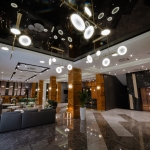06 SEPTEMBER 2019 Y.
Not far from Ark there is a complex of richly decorated mosque, small minaret and basin called Bolo-Khaus Complex. The mosque was built 300 years ago by wife of a wealthy Emir. The mosque still works. Once, Emir of Bukhara used to walk along red carpets from Ark to this mosque to pray and to be closer to his people. It is amazing that during the overall decline of architecture and art such an amazing exquisite building was constructed.
The mosque has an ayvan from 20 skillfully decorated columns which by reflecting in water gave the second name to the complex – “The Mosque of Forty Columns”. The pond itself, one of the few basins in Bukhara, was drained in 1920th because of cholera epidemic.
Next to the mosque there is a minaret which was built later than mosque. It is notable that after the Revolution the minaret started falling just as many others in Bukhara. Elderly said that it was the decline of faith and that there is something behind falling of minarets in holy city. Despite acute shortage of money, young Soviet Government decided to save architectural monuments. Minarets were straightened with the help of special construction. “Strings” using which they were stretched people called “music of Satan” as they made mournful sounds. Nevertheless, minarets including Bolo-Khaus were saved and today we see it in the way as it had been built in 1718.
The interior of the mosque is incredibly beautiful. Despite that the mosque works and believers still pray there, are allowed to enter inside as well (after taking their shoes off) and admire the decoration of the interior. Lightning system was thought over in smallest details.
Believers pray inside and outside the mosque on special carpets.
Bolo-Khaus Mosque is one of the most impressive attractions in Bukhara – an appeasing place with wonderful metaphysical feeling. It is one the beloved mosques by townsperople. When the center of town used to be in this area, lots of public offices, markets, and chaikhonas (tearoom in Central Asia) were located here.














